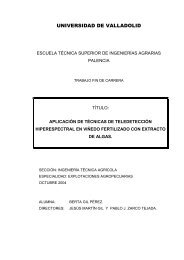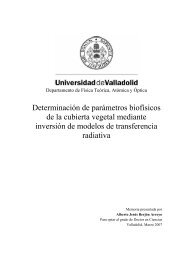10th INTERNATIONAL VERTICILLIUM SYMPOSIUM 16-20 ...
10th INTERNATIONAL VERTICILLIUM SYMPOSIUM 16-20 ...
10th INTERNATIONAL VERTICILLIUM SYMPOSIUM 16-20 ...
Create successful ePaper yourself
Turn your PDF publications into a flip-book with our unique Google optimized e-Paper software.
IMPROVEMENT OF INOCULATION METHODS FOR FINDINGRESISTANCE OF OLIVE TO <strong>VERTICILLIUM</strong> WILT CAUSEDBY <strong>VERTICILLIUM</strong> DAHLIAETRAPERO, C. (g3trrac@uco.es), RALLO, L. (ag1rarol@uco.es), BLANCO-LÓPEZ,M.A. (ag1bllom@uco.es) AND LÓPEZ-ESCUDERO, F.J. (ag2loesj@uco.es)Department of Agronomía, Universidad de Córdoba, Campus Univ. Rabanales, Edificio CelestinoMutis, 14071, Córdoba, SpainThe use of resistance is one of the most important mean of control ofVerticillium wilt of olive (VWO), caused by Verticillium dahliae. Olive shows a widesource of genetic variability that can be explore for finding resistance. Nevertheless,developing effective inoculations methods that allow to differentiate resistant fromsusceptible reactions, to short incubation period of infections, and to reduce space andtime for obtaining results, is necessary. The objective of this work was to developrapid, reliable and effective methods for screening a great number of olive genotypesfor resistance to VWO in young plants. Three methods (transplanting to a naturalinfested soil, bare-root dip and direct dipping of plant cultivation tray, in a conidialsuspension) were tested. Moreover, three types of plant material of ‘Picual’ (9-monthwild olive seedlings, and 9 and 2-month rooted olive cuttings), were assessed. Afterinoculations, plants were grown in controlled conditions, and disease severity weeklyevaluated by assessing symptom severity, using a 0-4 scale. Root dip-inoculated wildolive seedlings and nine-months rooted olive cuttings showed similar onset anddisease development, exhibiting symptoms from the 4 th week after inoculation, andreaching at 15 weeks after inoculation a final mean severity and percentage of deadplants, of 3.3 and 3.9, 68 and 90%, respectively. Disease incidence was the 100% inboth treatments. On the contrary, two-month rooted olive cuttings root-dip inoculatedshowed no symptoms during recording period. Moreover, disease symptoms were notobserved in any plant material inoculated by dipping of cultivation trays. Plantsgrowing in infested soil have not showed wilt symptoms yet, and are currently beingevaluated. Olive seedlings can be successfully infected by V. dahliae, and plants showconsistent symptoms. Therefore, root dip inoculation of seedlings could be aneffective and useful method for identifying resistance in olive. This method also savestime and space in comparison with standard inoculation methods of older plants, suchas nine-moths rooted cuttings, commonly used up to now in routine inoculationexperiments. Finally, additional trials currently conducted, have preliminarilydemonstrated that seedlings age for infection success by the pathogen, using root dipor stem puncture inoculation, could be reduced to 5 weeks.70




